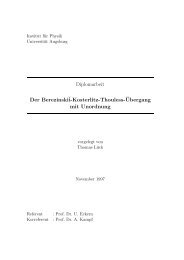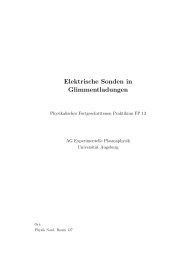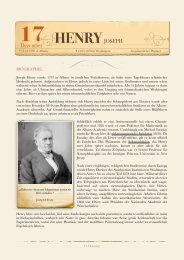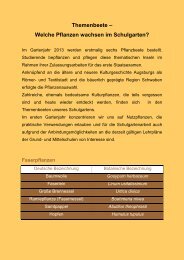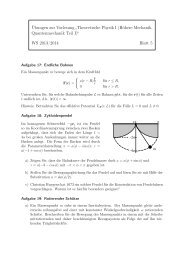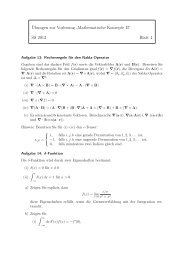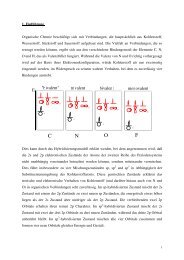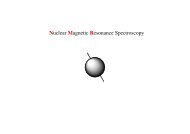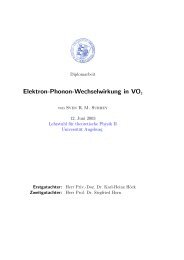PhD Thesis - Universität Augsburg
PhD Thesis - Universität Augsburg
PhD Thesis - Universität Augsburg
You also want an ePaper? Increase the reach of your titles
YUMPU automatically turns print PDFs into web optimized ePapers that Google loves.
34 2. Density-Matrix Renormalization Group<br />
Figure 2.1: Sketch showing superblock consisting of the system and the environment<br />
blocks, and the system block constructed with a block L(l) and a site l.<br />
and the corresponding B i (s i ) matrices. Forthcoming sections will describe the construction<br />
and the optimization of all A l (s l ) and B i (s i ) for the entire system (l, i = 1, . . .,L).<br />
In the above outlined “growing” procedure the block size is increased iteratively, adding<br />
one site at every step, until the desired length L is reached. f Consequently, the block at<br />
some step becomes a part of another, bigger one at the following steps. To avoid strong<br />
boundary effects during this procedure, White proposed [255, 256] to embed the block,<br />
which we might call the system block, into another one called the environment block, and<br />
search for the reduced representation of it in the environment given by the superblock<br />
(system + environment block) state. g Later in the subsection we will see that embedding<br />
into the environment for avoiding strong boundary effects has a deeper meaning, but at<br />
this stage let us follow a historical development of this concept.<br />
Let us look into this matter more precisely. Assume that at some point we reached<br />
a block of length l with a state space of dimension a l spanned by a set of orthonormal<br />
vectors {|α l 〉}. Now one site is added to it resulting in a system block (S) which has a<br />
n S = a l · d l+1 dimensional Hilbert space H S with a basis {|α l 〉 ⊗ |s l+1 〉 ≡ |α l s l+1 〉} =: {|i〉}.<br />
To avoid strong boundary effects we embed the system block into an “environment” (E)<br />
consisting with remaining sites of the lattice. This is schematically depicted in Fig. 2.1.<br />
At this point and for the following discussion it is not important whether the environment<br />
contains all remaining sites or just a part of them. Let n E be the size and {|j〉}<br />
the complete orthonormal basis of the Hilbert space H E of the environment block. Now<br />
we wish to determine a procedure which finds a set of orthonormal system-block states<br />
{|α l+1 〉} that spans an m := a l+1 n S dimensional subspace H L(l+1) of H S and gives the<br />
f It is not necessary to have a fixed L from the beginning. It can be identified as the size of the system<br />
for which the convergence in some quantity was reached.<br />
g Sometimes the name system/environment block is missleading, because at the end we are interested in<br />
features of the entire system (superblock). It is less confusing just to use the names left and right blocks,<br />
but it still will be a good concept to give a name system to the block whose states are going to be optimized<br />
and the rest name as an environment.



